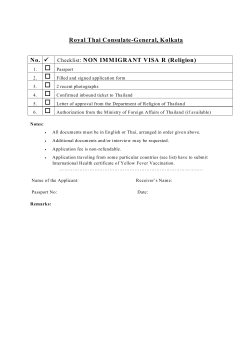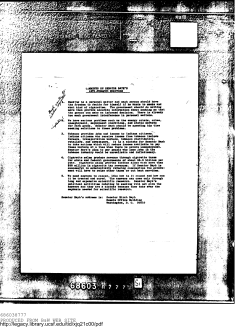
Document 189259
-Thailand
International
Health Policy
Program
-Thailand
International
Health
Policy
Program
How to design and implement effective
public health to prevent and mitigate
the impact of disease:
experiences from Thailand and beyond
Phusit Prakongsai, MD. Ph.D.
Walaiporn Patcharanarumol, MSc. Ph.D.
Viroj Tangcharoensathien, MD. Ph.D.
International Health Policy Program (IHPP) - Thailand
Presentation to the World Bank workshop on
‘Managing Vulnerability in East Asia and the Pacific’
26 June 2008
The Siam City Hotel
International
Health Policy
Program
-Thailand
International
Health
Policy
Program
-Thailand
Outline of presentation
• Burden of disease in Thailand in 2004
• Two examples of public policies and disease
prevention in Thailand:
– Control of tobacco consumption in Thailand
– HIV/AIDS
• Health expenditure in Thailand in 2001 and 2005
• Innovative financing on health promotion
• Conclusions and policy recommendations
2
Disability adjusted life years (DALY) loss in Thailand
by three major categories in 2004
Group III,
0.3
Group I,
1.2
Group III,
1.0
Group I,
0.9
Group II,
3.4
Group II,
3.1
Male
Female
Total = 9.9 Million DALYs (Males: 5.7 , Female: 4.2)
Group I Infections, maternal, perinatal and nutritional conditions = 2.1 Million DALYs
Group II Non-communicable diseases = 6.5 Million DALYs
Group III Injuries = 1.3 Million DALYs
Source: Thai Burden of Disease (BOD) Study
Top ten: DALY loss in Thailand in 2004
DALY
Male
Rank
Disease
1 HIV/AIDS
2 Traffic accidents
3 Stroke
4 Alcohol dependence/harmful use
5 Liver and bile duct cancer
6 COPD
7 Ischaemic heart disease
8 Diabetes
9 Cirrhosis
10 Depression
% of Total
Female
DALY
%
('000)
645 11.3
584 10.2
332
5.8
332
5.8
280
4.9
187
3.3
184
3.2
175
3.1
144
2.5
137
2.4
52.6
%
7.4
6.9
6.4
4.6
3.4
3.0
3.0
2.8
2.7
2.6
42.8
Source: Thai Burden of Disease (BOD) Study
DALY
Disease
('000)
313 Stroke
291 HIV/AIDS
271 Diabetes
191 Depression
142 Ischaemic heart disease
125 Traffic accidents
124 Liver and bile duct cancer
118 Osteoarthritis
115 COPD
111 Cataracts
Prevalence of regular smoking in Thailand from 1991 to 2006
Prevalence of regular
smoking (per 100
population)
35
30.46
30
25.36
25
22.47
20
19.47
18.94
15
10
5
0
1991
1991
4.6
1996
2.97
2001
2.42
2004
2.11
2006
2
0
1996
2001
2004
2006
55.63
49.21
42.93
37.16
36.91
10
20
30
40
50
60
Prevalence in male (per 100 population)
Prevalence in female (per 100 population)
Source: Tobacco Control Research and Knowledge Management Centre (TRC)
Public policies in reducing regular smoking and
morbidity in Thailand
• Currently, Thailand has a strong comprehensive tobacco control policy
• It took almost four decades of effective tobacco control efforts
• Effective interventions through the Framework Convention on Tobacco
Control (FCTC):
The regular tax increase policy is on course,
Total bans on smoking in public places with strong enforcement,
Total bans on advertising and cigarette displays and strong enforcement,
Pictorial health warnings on cigarette packages.
–
–
–
–
3,000
90
79
80
55
2,000
50
40
1,500
30.5
25.4
30
22.5
19.5
20
18.9
49
48
25
25
46
47
25
45
25
44
25
43
25
25
41
42
25
40
25
39
25
38
25
25
36
37
25
25
35
0
34
0
25
1,000
500
10
25
percent
60
prevalence of year
cigarette smoking
percent of excised tax on tobacco
Number of cigarette consumption in million packs
Number of cigarrette
consumed (million
packs)
2,500
70
Smoker Die
From Emphysema
Cigarette
Smoke Kill
Cigarette Smoke
Cause
Lung Cancer
Examples of health warning on cigarette
packages in 2005
International
Health Policy
Program
-Thailand
International
Health
Policy
Program
-Thailand
Key successes of tobacco control in Thailand
• There is a need to have a champion (either GO or
NGOs) who work patiently and continuously with
legislators and regulators as well as policy makers,
• Being direct, clear, and ready with realistic proposals
to offer politicians,
• Policy-relevant research is very important in
mobilizing public opinion and lobbying for
government actions, especially for Minister of
Finance and Minister of Health,
• Nationalism and cultural values can be successfully
used to encounter tobacco promotion from
international tobacco companies.
8
Enormous current benefits of prior prevention
efforts towards HIV/AIDS control in Thailand
Baseline
Current HIV Infections in millions
10
8
Red line represents what
might have been if
behaviors had not changed
No Intervention
7.1
Infections
prevented
6
4
2
0
1985
0.7
1990
1995
2000
2005
2010
Outcome of introducing prevention of motherto-child transmission of HIV (PMTCT) in 2000
Pediatric AIDS cases in Thailand 1984 – 2003
1400
1208 1250
1200
1000
1145
1061
915
907
803
800
680
600
461
400
277
200
21
74
136
29
0
19841990
1991
1992
1993
1994
1995
1996
MOPH Thailand, Epidemiology Division
1997
1998
1999
2000
2001
2002
2003
Inadequate health expenditure for health promotion and
disease prevention in Thailand
• From 2001 to 2005,
health expenditure
for health promotion
and disease
prevention in
Thailand decreased
from 8% to 4.8%.
Health administration
and health insurance
8.5%
Gross capital
formation
3.9%
• The majority of
health expenditure
was for curative
services and
rehabilitation, 79% in
2001 and 78% in
2004.
Prevention and
public health services
4.8%
Medical goods
4.3%
Ancillary services
0.4%
Services of curative
& rehabilitative care
78.1%
Innovative financing for health promotion:
Thai Health Promotion Foundation (THPF)
• THPF is a statutory public organization established by the
Health Promotion Foundation Act in 2001
• The Fund is an innovative financing mechanism
generating revenue from 2% surcharge of alcohol and
cigarette sales
• Its mission is to empower civic society and promotes
well-being of the citizens by acting as a catalyst and
provide financial support for health promotion projects,
• Three main factors for early achievements of THPF
– Financial sustainability,
– Accountable agency with efficient management structure,
– Effective strategies in promoting public health and policies
International
Health Policy
Program
-Thailand
International
Health
Policy
Program
-Thailand
Conclusions and policy recommendations
• Sustaining positive public policies in controlling tobacco
consumption and reducing other major disease burden e.g.
alcohol consumption, road traffic accident, diabetes, and
hypertension, hyper-lipidemia, etc.
• Increasing level of financing health promotion and disease
prevention (primary, secondary, and tertiary prevention),
• Increasing value of money through applying cost-effective
clinical prevention and health promotion suggested by the
Disease Control Priority for Developing Countries (2nd edition),
• Improving program effectiveness (technical efficiency) in
health promotion and disease prevention,
• Sustain and accelerate the work of Thai Health Promotion
Foundation through:
– Increase the level of sin tax from 2% to 5%,
– Diversify the portfolio of the THPF to cover more cost-effective
interventions, esp. effective coverage of interventions focusing on
chronic NCD .
13
© Copyright 2025





















